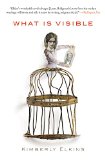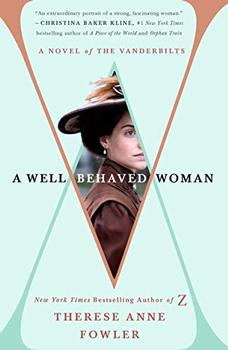Summary | Excerpt | Reviews | Beyond the book | Read-Alikes | Genres & Themes | Author Bio

"Without Laura Bridgman there could never have been a Helen Keller," philosopher William James declared. Yet Laura has been largely forgotten, whereas Helen is an inspirational household name. Who was Laura Bridgman, and why was she so famous in her time? With her debut novel, Kimberly Elkins imagines Laura's rich inner life and places her within a fertile mid-century New England context – replete with educators, scientists, and reformers, but also with the threat of war and debates over slavery and religion.
 The novel is bookended by scenes set in 1888, when fifty-eight-year-old Laura meets eight-year-old Helen Keller, "my presumptive heir." They have a mutual friend, Annie Sullivan, who learned the manual alphabet (see 'Beyond the Book') from Laura. Helen asks Laura which sense she would choose to regain. "Sight," she replies, "for life has been dark for over half a century." Indeed, she has been devoid of all senses, bar touch, since scarlet fever hit at age two. "So I write this out into the air...that what is invisible to man may be visible to God."
The novel is bookended by scenes set in 1888, when fifty-eight-year-old Laura meets eight-year-old Helen Keller, "my presumptive heir." They have a mutual friend, Annie Sullivan, who learned the manual alphabet (see 'Beyond the Book') from Laura. Helen asks Laura which sense she would choose to regain. "Sight," she replies, "for life has been dark for over half a century." Indeed, she has been devoid of all senses, bar touch, since scarlet fever hit at age two. "So I write this out into the air...that what is invisible to man may be visible to God."
Within this framing story, the novel fills in the chronological arc of Laura's life, beginning in 1842, with Laura a twelve-year-old pupil at Samuel Gridley Howe's Perkins School for the Blind outside Boston. She is not just Dr. Howe's showpiece, but a celebrity in her own right. Laura dolls are popular keepsakes, and she sells her autographs and crocheted purses for pocket money. On his tour of the United States, Charles Dickens eagerly paid a visit to Laura, later devoting a whole chapter of his American Notes to her. Yet she is also somewhat frightening: she slaps, bites, and makes primitive growling noises. The pseudo-science of phrenology, which makes frequent appearances, even suggests that she lacks "moral rectitude" and has enlarged "animal regions."
Laura's relationship with Howe is paramount in the novel. With a nearly thirty-year age gap between them, she sees him as a surrogate father but also harbors secret romantic feelings, while he thinks of her as "the girl he had made" – the Eliza Doolittle to his Henry Higgins. Howe's engagement to Julia Ward, the poet who wrote "The Battle Hymn of the Republic," makes Laura jealous, while Julia resents the attention her husband pays Laura. The uneasy links between these characters make for some delicious narrative tension. Other key figures are Laura's nurse-companion, Sarah Wight, who eventually joins her missionary husband in Hawaii; Kate, a (fictional) cook who teaches Laura to taste through doses of whisky, garlic, and honey; and Howe's best friend, Charles Sumner, who is nearly beaten to death on the Senate floor by a pro-slavery opponent.
It is delightful to watch such historical figures flit in and out of the novel like cameo actors: the poet Henry Wadsworth Longfellow is one of Julia's mentors, Howe is an ardent supporter of John Brown, and reformer Dorothea Dix is an occasional visitor. Especially as the Civil War approaches, Elkins powerfully conveys the ways these characters both participate in and resist the movements of history. Everyone expects Laura to have sympathy for the plight of the slaves, for instance, but the insularity of her condition means she cannot always see beyond herself: "I AM NOT FREE," she insists to Julia and Howe, "You are all black to me."
Elkins elaborates on the title's contrast between the visible and the unseen through a sensitive depiction of Laura's spiritual journey. Laura fancies herself a blind seer like those in Greek mythology – and, indeed, she seems to have extrasensory powers: she accurately predicts the sex of Julia's third child, and one touch of John Brown's hand leads her to pronounce him a madman. Moreover, she has always been curious about the supernatural – "God is the one person in the whole world that I have the most questions for" – but Howe, a Unitarian, forbids her from reading the Bible or attending church. Over the years, her faith ebbs and flows, but she remains convinced that there is more to life than the physical. Even in her darkest moments, wondering why God let her survive the fever, or remembering a society girl asking why she has not committed suicide, Laura's vitality and determination shine through.
One of the pleasures of the novel's structure is following Laura's development from an adolescent into an adult, as her narrative voice becomes more advanced and world-weary. Elkins alternates passages from Laura's first-person perspective with third-person chapters giving the point-of-view of Howe, Julia, and Sarah. The epilogue and afterword reveal that nearly all the novel's elements are based on documented history. Where Elkins breaks from the historical record – in creating a love interest for Laura, for example – it is always for good reason, and with plausible support.
As the novel loops back to that climactic meeting with Helen Keller, Laura thinks of herself as "a present to them all from God, to show how little one can possess of what we think it means to be human while still possessing full humanity." What is visible here? Not only the myriad developments of a half century in American history and the whole span of a remarkable existence, but also a glimpse into how love and purpose can make any life worthwhile.
Picture of Laura Bridgman by Warren. Bridgman wore a green ribbon eyeshade, or opaque glasses, throughout her life. Dr. Howe would not let her get glass eyes.
Additional Information
The novel What Is Visible has been germinating for over a decade; Elkins published a related short story in The Atlantic in March 2003 and a different version of it then appeared in Best New American Voices 2004 and McGraw-Hill college textbook Arguing Through Literature. The prologue appeared (also in a different version) as a story in The Drum, and a version of chapter 17 appeared in the Chicago Tribune literary supplement.
![]() This review was originally published in The BookBrowse Review in June 2014, and has been updated for the
July 2015 edition.
Click here to go to this issue.
This review was originally published in The BookBrowse Review in June 2014, and has been updated for the
July 2015 edition.
Click here to go to this issue.

If you liked What Is Visible, try these:

by Clare Beams
Published 2021
Sarah Waters meets Red Clocks in this searing novel, set at an all-girl school in 19th century Massachusetts, which probes the timeless question: who gets to control a woman's body and why.

by Therese Anne Fowler
Published 2019
The riveting novel of iron-willed Alva Vanderbilt and her illustrious family as they rule Gilded-Age New York, from the New York Times bestselling author of Z: A Novel of Zelda Fitzgerald.






Your guide toexceptional books
BookBrowse seeks out and recommends the best in contemporary fiction and nonfiction—books that not only engage and entertain but also deepen our understanding of ourselves and the world around us.